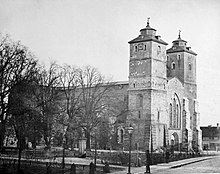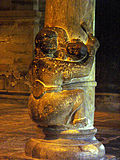Lund Cathedral
The Lund Cathedral ( Swedish : Lunds domkyrka , Danish : Lund Domkirke ) in the southern Swedish city of Lund and the historic province of Skåne in today's southern Sweden , was built from 1104 in the Romanesque architectural style and is therefore the oldest cathedral in Scandinavia . Asker , the first Archbishop of Lund since 1103 , consecrated the crypt in 1123. The completed cathedral was consecrated in 1145 by Archbishop Eskil to Laurentius of Rome . The towers were rather unadorned in the Middle Ages. They were given their current form in 1863 based on a design by Helgo Zettervall . The cathedral has been an episcopal church since it was built.
location
The cathedral is located in the middle of the medieval city center, south of Lundagård , in the Centrala staden district . Noteworthy buildings in the immediate vicinity are the Kungshuset north of the cathedral, the main building of the university to the northwest, the building of the Academic Association to the northeast, and the Liberiet cathedral chapter house to the southeast.
history
Until 1658 Lund and the Skåne region belonged to Denmark . The diocese of Lund came into being in 1060 when the Danish King Sven Estridsson divided the then diocese of Roskilde . Initially, two dioceses were established in Skåne. The Bishop of Lund was ordained by the Archbishop of Canterbury . The other diocese was in Dalby , only ten kilometers from Lund, and was headed by a German mission bishop . The close connection with England broke off after 1066, when the Danish crown lost the Danelag .
In 1085 a bishop's church was built where the cathedral is today. The initiative came from King Canute the Holy - the later patron saint of Denmark - who created the economic prerequisites for the cathedral monastery and a future arch- cathedral with a large donation . At that time the two Skåne dioceses were already united under a German bishop and subordinated to the Archdiocese of Bremen-Hamburg .
In 1103, King Erik I succeeded in obtaining the ecclesiastical independence of Scandinavia from the Archdiocese of Bremen-Hamburg when he visited the Pope in Rome during his pilgrimage to Jerusalem . Lund was raised to the ecclesiastical center of all of Northern Europe.
However, Erik I never saw his kingdom again, but died on the same trip in Cyprus without having reached Jerusalem. His successor on the throne was his younger brother Niels . Together with Archbishop Asker , King Niels planned and began the construction of a dignified episcopal church. Already in 1123 the crypt and in 1145 the high altar , d. H. the cathedral itself consecrated.
Lund's importance as a religious center declined when the Archdiocese of Nidaros was founded for Norway in 1158 and the Archdiocese of Uppsala for Sweden, including Finland , in 1179 .
Towards the end of the Middle Ages there were 27 churches in the city of Lund, eight of which belonged to different monasteries - the number appears to be particularly high from today's point of view, but was not at the time, Cologne had 19 parishes and up to the secularization in 1794, 168 were public accessible churches and chapels probably almost as many closed ones in monasteries and private houses. The Reformation in Denmark , however, only survived the cathedral, the associated cathedral school and the Saint Peters monastery church (pictures of the monastery church) . The general economic and political supremacy of the church in Denmark had expired.
The Lund diocese came to Sweden after the Peace of Roskilde in 1658. The church and the university , which was founded ten years later, played an important role in the integration of Skåne into the Kingdom of Sweden. The university now used parts of the church for lectures.
Lund and the already mentioned Dalby are located on the south side of Horstes Romeleåsen , overlooking a large part of southern Scania. Like the former bishop's church in Dalby, Lund Cathedral is built over a spring which clearly indicates pre-Christian cult sites and is surrounded by fertile soil on a flat land that is very suitable for agriculture.
Celebration on the occasion of the Reformation anniversary
On October 31, 2016, the President of the Lutheran World Federation , Bishop Munib A. Younan, will celebrate a joint divine service with Pope Francis in Lund Cathedral in view of the Reformation anniversary in 2017 under the motto “From Conflict to Community - United in Hope”. The Lutheran World Federation was founded in Lund in 1947.
building
The building is a Romanesque pillar basilica based on Lombard- Rhine models. The influence of northern Italy is evident from the floor plan, the spacious crypt , the house decorations and the dwarf gallery that surrounds the choir apse . The northern Italian influence came about Speyer and Mainz to Northern Europe and also worked on the cathedrals of Ribe and Viborg .
After a serious fire in the 13th century, the central nave was given six-part Gothic ribbed vaults and better lighting thanks to an early Gothic window group between the towers.
During the late Gothic renovation by Adam van Düren between 1510 and 1527 , the statics of the ship were reinforced by flying buttresses .
In the 18th century, part of the sandstone façade had to be renewed, and the central and transepts were given baroque mansard roofs .
An extensive renovation took place in the 19th century. It began in 1845/46 at the crypt and was then continued by Carl Georg Brunius ( EN / SV ) . Finally, in 1860–1880, Helgo Zettervall tried to give the building the most Romanesque appearance possible and replaced many important Gothic components with neo-Romanesque .
From 1921 to 1927 the design of the apse was done with a mosaic "Christ on Last Day in the aura of light, while angels wake the dead." It was made by the Danish sculptor Joakim Skovgaard with the help of Agnete Varming (1897-1983), Elof Risebye (1892–1961) and Hugo Gehlin (1889–1953).
Sculptures
There are columns in the medieval architecture of northern European churches in which the male figure appears to emerge from the column. It is actually no longer included in the carrying process of the heavy architectural part, so such columns can no longer be called atlases . Because the load is transferred to the entire column via the capital . Here it only has a purely decorative meaning of the column from which it is carved. Only in this capacity does it have a function of dividing space. The clothing of the female figures is Nordic and not Mediterranean . Using the example of Lund Cathedral in Sweden , a crouching female figure can be seen on a column base with a newborn child in her arms, who is clinging to the shaft of the column. As Kouros or Kore in the sense of pure Greek tradition such representations can not call.
It is conceivable, but unlikely, that they found their way there from the tradition of Greek or Roman architecture. The origins of the figural columns of Lund Cathedral are explained with the following legend: In 1103/04, Pope Paschal II built the Archdiocese of Lund on the Danish initiative, the cathedral of which was subsequently built, which is also the oldest in Scandinavia . There is a so-called "Finn" sculpture in the crypt . It is said to be about a giant with whom St. Laurentius is said to have concluded a pact for the building of the church, as a result of which he would lose his eyes if he did not guess the name of the giant until it was completed. He overheard the woman talking to her son and heard the name "Finn". He called the giant by name, whereupon he and his family jumped into the crypt and froze to stone.
The cathedral was extensively changed in the 19th century, e.g. B. 1863 complete redesign of the towers and the (west) facade.
Choir stalls
The cathedral is characterized by the large high choir , in which the oak choir stalls from the middle of the 14th century stand on both sides.
Astronomical clock
The clock with carillon on the right of the main entrance and the mosaic in the apse deserve special attention . The Horologium mirabile Lundense astronomical clock was installed at the end of the 14th century and is possibly the work of Nikolaus Lilienfeld . This clock is still in the church, even though it was improved several times over the centuries. A moon hand shows the phase of the moon and its position in the sky, a sun hand shows the time on a 24-hour clock, and there is also a zodiac hand . When the clock plays, wooden hornblowers raise their horns. A small gate opens to the sounds of the song of praise In dulci jubilo , with a procession of the three kings bowing past Mary with the baby Jesus. The three wooden kings also represent the peoples from the three continents known at the time, Europe, Asia and Africa.
organ
There are five organs in the cathedral . In addition to the main organ, there are three smaller instruments in the crypt, the baptistery and in the choir room. In addition, a small organ is installed in the astronomical clock; she plays the song " In dulci jubilo " every day .
The large organ in the west stand was built between 1932 and 1934 by the Danish organ builder Marcussen & Søn. The instrument has 101 stops (7,074 pipes) on four manual works and a pedal and was last extensively restored by the builder company in 1992. The organ is the largest church organ in Sweden.
|
|
|
|
||||||||||||||||||||||||||||||||||||||||||||||||||||||||||||||||||||||||||||||||||||||||||||||||||||||||||||||||||||||||||||||||||||||||||||||||||||||||||||||||||||||||||||||||||||||||||||||||||||||||||||||||||||||||||||||||||||||||||||||||||||||||||||||||||||||||||||||||||||||||||||||||||||
|
|
|
|
||||||||||||||||||||||||||||||||||||||||||||||||||||||||||||||||||||||||||||||||||||||||||||||||||||||||||||||||||||||||||||||||||||||
- Coupling : II / I, III / I, III / II, IV / I, IV / II, IV / III, I / P, II / P, III / P, IV / P
See also
Individual evidence
- ↑ domradio.de - Romanesque churches between "Euko" and UNESCO
- ↑ Interview with the Swedish Archbishop Antje Jackelén ( Memento of the original from November 1, 2016 in the Internet Archive ) Info: The archive link was inserted automatically and has not yet been checked. Please check the original and archive link according to the instructions and then remove this notice. at ekd.de. Quote: “It is also important for us to emphasize that the World Federation and Rome invite you together. We in Sweden are the local hosts. It has certainly never happened in five hundred years that we have celebrated Reformation Day together. "
- ↑ Charl. Refuses: Joakim Skovgaard: on the occasion of his seventieth birthday. In: Kunst und Künstler: illustrated monthly for fine arts and applied arts , 25.1927, issue 8, pp. 317–318
- ↑ Skovgaard, Joakim. In: Kunstindeks Danmark / Weilbachs Kunstnerleksikon (Danish).
- ↑ Manfred Schukowski : Wunderuhren: astronomical clocks in churches of the Hanseatic period. Thomas Helms Verlag Schwerin 2006, ISBN 3-935749-03-1 , p. 80f.
- ↑ Lunds Domkyrka
- ↑ Information on the organ and its disposition , accessed on February 28, 2018.
Web links
- Lunds Domkyrka (da / de / en / es / pl / sv)
Coordinates: 55 ° 42 ′ 14.6 " N , 13 ° 11 ′ 36.9" E














